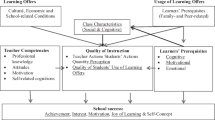Abstract
Early childhood curricula should be authentic and child-centered, however, many teachers still rely on direct instruction lessons. To better define how an integrated curriculum meets the needs of students, this study examined teacher talk and actions during instructional activities with first and second graders under two conditions: (1) subject-integrated social studies lessons of an integrated curriculum unit (experimental condition); and (2) single subject-focused mathematics lessons of a traditional separate subject curriculum (control condition). The mixed-methods study sought to define and compare characteristics of both curriculum approaches. Fourteen hours of observations were collected in each setting. In the integrated curriculum setting, the teacher was a facilitator of teamwork, offering choices, and giving praise; students made choices, decisions, and worked collaboratively. In the traditional setting, the teacher delivered direct instruction and controlled behavior; students followed directions, recalled knowledge, and worked individually. Less teacher energy was expended for behavior management in the integrated curriculum setting, indicating intrinsic motivation of students. Implementation of integrated curricula is recommended because of the student-centered focus that results in greater motivation, ownership, and teamwork, along with deeper knowledge connections. Because many factors hinder implementation, teachers need support when first teaching with this approach.
Similar content being viewed by others
References
Anfara, V. A., Jr., & Lipka, R. P. (2003). Relating the middle school concept to student achievement. Middle School Journal, 35(1), 24–32.
Au, W. (2007). High-stakes testing and curricular control: A qualitative metasynthesis. Educational Researcher, 36(5), 258–267.
Basir, M. A., Alinaghizadeh, M. R., & Mohammadpour, H. (2008). A suggestion for improving students’ abilities to deal with daily real-life problems. Physics Education, 43(4), 407–411.
Boyle-Baise, M., Hsu, M., Johnson, S., Cayot Serriere, S., & Stewart, D. (2008). Putting reading first: Teaching social studies in elementary classrooms. Theory and Research in Social Education, 36(3), 233–255.
Bresler, L., & Latta, M. M. (2009). Syntegration or disintegration? Models of integrating the arts across the primary curriculum. International Journal of Education and the Arts, 10(28), 1–23.
Center on Education Policy. (2008). Instructional time in elementary schools: A closer look at changes for specific subjects. Washington, DC: Author.
Dowden, T. (2007). Relevant, challenging, integrative and exploratory curriculum design: Perspectives from theory and practice for middle level schooling in Australia. The Australian Educational Researcher, 34(2), 51–71.
Dye, J. F., Schatz, I. M., Rosenberg, B. A., & Coleman, S. T (2000). Constant comparison method: A kaleidoscope of data. The Qualitative Report, 4(1–2) Retrieved 13 Feb 2010 from http://www.nova.edu/ssss/QR/QR4-1/dye.html.
Edwards, C. P., & Willis, L. M. (2000). Integrating visual and verbal literacies in the early childhood classroom. Early Childhood Education Journal, 27(4), 259–265.
ERIC Development Team. (2000). Integrative curriculum in a standards-based world. ERIC Digest. ERIC Document Reproduction Service No. ED 441618.
Goetz, J. P., & LeCompte, M. D. (1981). Ethnographic research and the problem of data reduction. Anthropology and Education Quarterly, 12, 51–70.
Hardman, M. L. (2009). Redesigning the preparation of all teachers within the framework of an integrated curriculum model. Teaching and Teacher Education, 25(4), 583–587.
Hinde, E. R. (2005). Revisiting curriculum integration: A fresh look at an old idea. The Social Studies, 96(3), 105–111.
Hockett, J. A. (2009). Curriculum for highly able learners that conforms to general education and gifted education quality indicators. Journal for the Education of the Gifted, 32(3), 394–440.
Kosslyn, S. M. (1978). Measuring the visual angle of the mind’s eye. Cognitive Psychology, 10(3), 356–389.
Lim, B. Y. (2004). The magic of the brush and the power of color: Integrating theory into practice of painting in early childhood settings. Early Childhood Education Journal, 32(2), 113–119.
Marshall, J. (2005). Connecting art, learning, and creativity: A case for curriculum integration. Studies in Art Education, 46(3), 227–241.
Mei, L. (2009). Bridging disciplinary boundaries. Education Canada, 49(3), 40–43.
Mertens, S. B., & Flowers, N. (2003). Middle school practices improve student achievement in high poverty schools. Middle School Journal, 35(1), 33–43.
Molenda, C. F., & Bhavnagri, N. P. (2009). Cooperation through movement education and children’s literature. Early Childhood Education Journal, 37, 153–159.
National Council of Teachers of Mathematics (NCTM). (2000). Principles and standards for school mathematics. Reston, VA: Author.
National Council of Teachers of Mathematics (NCTM). (2006). Curricular focal points for prekindergarten through grade 8 mathematics: A quest for coherence. Reston, VA: Author.
National Research Council (NRC). (1998). How people learn: Brain, mind, experience, and school. Washington, DC: National Academy Press.
Park, M. (2008). Implementing curriculum integration: The experiences of Korean elementary teachers. Asia Pacific Education Review, 9(3), 308–319.
Rule, A. C. (2006). The components of authentic learning. Journal of Authentic Learning, 3(1), 1–10.
Rule, A. C., & Barrera, M. T. III. (2008). Three authentic curriculum-integration approaches to bird adaptations that incorporate technology and thinking skills. ERIC Document Reproduction Service No. ED 501247.
Slavin, R. (2007). Educational research in an age of accountability. Upper Saddle River, NJ: Pearson Education Inc.
Stegelin, D. A. (2003). Application of the Reggio Emilia approach to early childhood science curriculum. Early Childhood Education Journal, 30(3), 163–169.
Trent, A., & Riley, J. (2009). Re-Placing the arts in elementary school curricula: An interdisciplinary, collaborative action research project. Perspectives on Urban Education, 6(2), 14–28.
Viglione, N. M. (2009). Applying art and action. Reclaiming Children and Youth, 18(1), 16–19.
Virtue, D. C., Wilson, J. L., & Ingram, N. (2009). In overcoming obstacles to curriculum integration, L. E. S. S. can be more! Middle School Journal, 40(3), 4–11.
Wraga, W. G. (2009). Toward a connected core curriculum. Educational Horizons, 87(2), 88–96.
Author information
Authors and Affiliations
Corresponding author
Rights and permissions
About this article
Cite this article
Zhbanova, K.S., Rule, A.C., Montgomery, S.E. et al. Defining the Difference: Comparing Integrated and Traditional Single-Subject Lessons. Early Childhood Educ J 38, 251–258 (2010). https://doi.org/10.1007/s10643-010-0405-1
Published:
Issue Date:
DOI: https://doi.org/10.1007/s10643-010-0405-1




